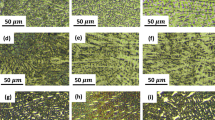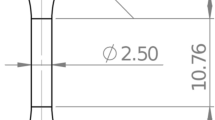Abstract
Inconel 718 is considered to be a superalloy with a series of superior properties such as high strength, creep resistance, and corrosion resistance at room and elevated temperatures. Additive manufacturing (AM) is particularly appealing to Inconel 718 because of its near-net-shape production capability for circumventing the poor machinability of this superalloy. Nevertheless, AM parts are prone to porosity, which is detrimental to their fatigue resistance. Thus, further understanding of their fatigue behavior is required before their widespread use in load-bearing applications. In this work, the microstructure and fatigue properties of AM Inconel 718, produced in a Laser Engineered Net Shaping (LENS™) system and heat treated with a standard heat treatment schedule, are evaluated at room temperature. Fully reversed strain controlled fatigue tests were performed on cylindrical specimens with straight gage sections at strain amplitudes ranging from 0.001 mm/mm to 0.01 mm/mm. The fracture surfaces of fatigue specimens were inspected with a scanning electron microscope. The results indicate that the employed heat treatment allowed the large, elongated grains and dendritic structure of the as-built material to break down into smaller, equiaxed grains, with some dendritic structures remaining between layers. The AM specimens were found to possess lower fatigue resistance than wrought Inconel 718, and this is primarily attributed to the presence of brittle metal-carbide/oxide inclusions or pores near their surface.




Similar content being viewed by others
Abbreviations
- \( 2N_{\text{f}} \) :
-
Reversals to failure
- AM:
-
Additive manufacturing
- \( b \) :
-
Fatigue strength exponent
- BD:
-
Build direction
- \( c \) :
-
Fatigue ductility exponent
- \( E \) :
-
Elastic modulus
- EDS:
-
Energy-dispersive x-ray spectroscopy
- LENS:
-
Laser Engineered Net Shaping
- R 2 :
-
Coefficient of determination
- SEM:
-
Scanning electron microscope
- \( \frac{{\Delta \varepsilon }}{2} \) :
-
Total strain amplitude
- \( \varepsilon_{\text{f}}^{{\prime }} \) :
-
Fatigue ductility coefficient
- \( \sigma_{\text{f}}^{{\prime }} \) :
-
Fatigue strength coefficient
References
H. Krain, A. Sharman, and K. Ridgway, J. Mater. Process. Technol. 189, 153 (2007).
D. Dudzinski, Int. J. Mach. Tool. Manuf. 44, 439 (2004).
C.E. Leshock and J.N. Kim, Int. J. Mach. Tool. Manuf. 41, 877 (2001).
N. Shamsaei, A. Yadollahi, L. Bian, and S.M. Thompson, Addit. Manuf. 8, 12 (2015).
L. Bian, S.M. Thompson, and N. Shamsaei, JOM 67, 629 (2015).
A.J. Sterling, B. Torries, N. Shamsaei, S.M. Thompson, and D.W. Seely, J. Mater. Sci. Eng. A 655, 100 (2016).
E. Amsterdam and G.A. Kool, ICAF Symp. 1261 (2009).
R.I. Stephens, A. Fatemi, R.R. Stephens, and H.O. Fuchs, Metal Fatigue in Engineering, 2nd ed. (New York: Wiley, 2001), p. 106.
Q. Chen, N. Kawagoishi, and H. Nisitani, J. Mater. Sci. Eng. A 277, 250 (2000).
X. Ma, Z. Duan, H. Shi, R. Murai, and E. Yanagisawa, J. Zhejiang Univ. Sci. A 11, 727 (2010).
C. Mercer, A.B.O. Soboyejo, and W.O. Soboyejo, J. Mater. Sci. Eng. A 270, 308 (1999).
H. Andersson and C. Persson, Int. J. Fatigue 26, 211 (2004).
D.W. Worthem, I.M. Robertson, F.A. Leckie, D.F. Socie, and C.J. Alstetter, Metall. Trans. A 21, 3215 (1990).
C. Mercer, A.B.O. Soboyejo, and W.O. Soboyejo, Acta Mater. 47, 2727 (1999).
N. Kawagoishi, Q. Chen, and H. Nisitani, Fatigue Fract. Eng. Mater. Struct. 23, 209 (2000).
C. Brinkman and G.E. Korth, J. Test. Eval. 2, 249 (1974).
ASTM E606/E606 M-12, ASTM International, West Conshohocken, PA, 2012.
X. Zhao, J. Chen, X. Lin, and W. Huang, J. Mater. Sci. Eng. A 478, 119 (2008).
F. Liu, X. Lin, G. Yang, M. Song, J. Chen, and W. Huang, Opt. Laser Technol. 43, 208 (2011).
P.L. Blackwell, J. Mater. Process. Technol. 170, 240 (2005).
Y. Chen, F. Lu, K. Zhang, P. Nie, S.R.E. Hosseini, K. Feng, and Z. Li, J. Alloys Compd. 670, 312 (2016).
H. Qi, M. Azer, and A. Ritter, Metall. Mater. Trans. A 40, 2410 (2009).
L. Xiao, M.C. Chaturvedi, and D.L. Chen, Metall. Mater. Trans. A 36, 2671 (2005).
Acknowledgements
All data in this study were generated at Mississippi State University’s Center for Advanced Vehicular Systems (CAVS).
Author information
Authors and Affiliations
Corresponding author
Rights and permissions
About this article
Cite this article
Johnson, A.S., Shao, S., Shamsaei, N. et al. Microstructure, Fatigue Behavior, and Failure Mechanisms of Direct Laser-Deposited Inconel 718. JOM 69, 597–603 (2017). https://doi.org/10.1007/s11837-016-2225-2
Received:
Accepted:
Published:
Issue Date:
DOI: https://doi.org/10.1007/s11837-016-2225-2




